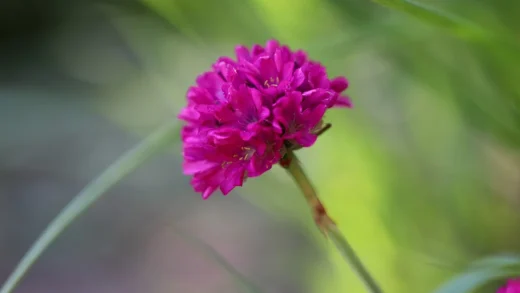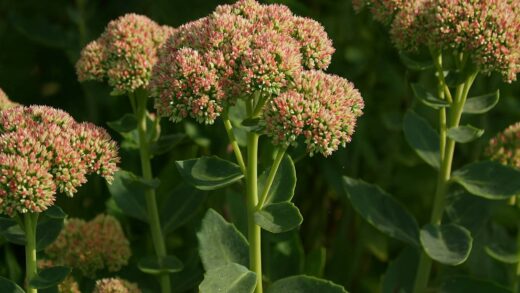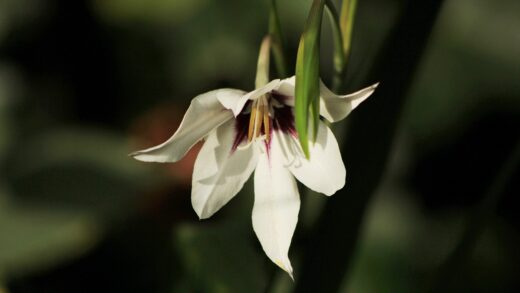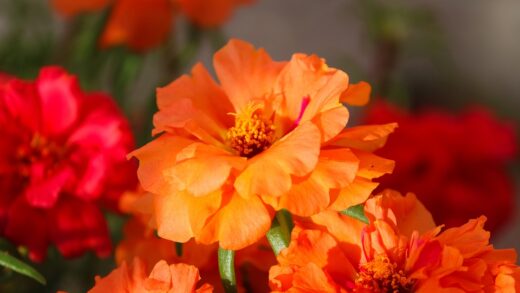Providing the appropriate level of nutrition for purpletop vervain is a delicate exercise in restraint, as this is a plant that truly thrives on a lean diet. Its natural inclination is to grow in soils of average to low fertility, and an overly rich environment can be more detrimental than beneficial. Understanding its modest nutrient requirements is key to cultivating a plant that is strong, structurally sound, and prolific in its flowering. The goal of any fertilization strategy should be to supplement the soil just enough to support healthy growth without encouraging the kind of lush, weak foliage that compromises the plant’s elegant form. A minimalist approach to feeding is not only easier for the gardener but is also precisely what this particular species needs to flourish.
The principle that ‘less is more’ is the guiding philosophy when it comes to fertilizing purpletop vervain. This plant has adapted to conditions where nutrients are not always readily available, and as a result, it is highly efficient at extracting what it needs from the soil. Bombarding it with high-strength, chemical fertilizers can disrupt this natural balance, leading to a host of problems. The most common outcome of over-fertilization is excessively vigorous vegetative growth at the expense of flowers. This results in a plant with an abundance of soft, green leaves and long, spindly stems that are unable to support themselves, ultimately detracting from the plant’s signature airy appearance.
Instead of a regime of regular chemical feeding, the focus should be on building a healthy, living soil. The incorporation of organic matter, such as well-rotted compost or leaf mould, at the time of planting is often the only soil amendment this plant will ever need. Organic matter provides a slow, steady release of a broad spectrum of essential nutrients, perfectly matching the plant’s modest appetite. It also offers the significant secondary benefit of improving soil structure, enhancing drainage in heavy soils and increasing water retention in sandy soils, thereby addressing the plant’s most critical needs simultaneously.
Recognizing the subtle signs of a genuine nutrient deficiency is also an important skill, although it is a rare occurrence with this species in typical garden soils. Symptoms such as pale, yellowing leaves or severely stunted growth might indicate a need for a nutritional boost. However, it is crucial to first rule out other potential causes for these symptoms, such as poor drainage, insufficient sunlight, or incorrect soil pH, which are far more likely to be the culprits. Only after these environmental factors have been addressed should you consider a light application of a balanced fertilizer as a potential solution.
The role of essential nutrients for verbena
While purpletop vervain is not a heavy feeder, it still requires a balanced supply of essential nutrients to carry out its fundamental physiological processes. The three primary macronutrients—nitrogen (N), phosphorus (P), and potassium (K)—each play a distinct and vital role. Nitrogen is crucial for vegetative growth, contributing to the development of healthy leaves and stems. Phosphorus is essential for energy transfer, root development, and, most importantly for this plant, the formation of flowers and seeds. Potassium plays a key role in the plant’s overall vigour, regulating water movement and enhancing its resistance to disease and environmental stress.
More articles on this topic
A balanced supply of these nutrients is critical. An excess of nitrogen, in particular, is the most common cause of problems related to fertilization. Too much nitrogen will stimulate the plant to produce an overabundance of leafy growth, resulting in a plant that is tall but weak and ‘floppy’. This lush foliage is also more susceptible to fungal diseases and pest attacks. Crucially, the plant will divert its energy away from reproductive processes, leading to a significant reduction in the number of flowers produced. The ideal nutritional environment is one that provides just enough nitrogen for healthy leaves, with sufficient phosphorus and potassium to support strong roots and prolific blooming.
In addition to the primary macronutrients, purpletop vervain also requires a range of micronutrients, such as iron, magnesium, and calcium, albeit in much smaller quantities. In a healthy garden soil that is rich in organic matter, these micronutrients are typically present in sufficient amounts. This is another reason why amending the soil with compost is so beneficial; it provides a complex array of these trace elements that are often absent in synthetic chemical fertilizers. A healthy, biologically active soil ecosystem helps to make these nutrients available for the plant’s roots to absorb.
Ultimately, the goal is to create a soil environment that offers a slow, steady, and balanced release of all the essential nutrients. This mirrors the conditions to which the plant is naturally adapted and supports the development of a strong, resilient, and floriferous specimen. The focus should always be on the long-term health of the soil rather than on providing short-term, high-impact feeding. This sustainable approach not only benefits the purpletop vervain but also contributes to the health of the entire garden ecosystem.
Choosing the right type of fertilizer
When it comes to selecting a fertilizer for purpletop vervain, organic options are almost always the superior choice over synthetic chemical formulas. Well-rotted garden compost stands out as the single best soil amendment and nutrient source for this plant. Incorporating a generous layer of compost into the soil at the time of planting provides a wealth of benefits. It supplies a balanced, slow-release source of essential macro and micronutrients, improves soil structure and drainage, and fosters a healthy population of beneficial soil microorganisms. For an established plant, a top dressing of compost applied around its base each spring is typically all the feeding it requires for the entire season.
More articles on this topic
If you feel that your soil is particularly impoverished and requires more than just compost, a balanced, slow-release granular organic fertilizer is the next best option. Look for a product with a relatively low and balanced N-P-K ratio, such as a 5-5-5 or a similar formulation. A slow-release fertilizer breaks down gradually over several months, providing a gentle and sustained supply of nutrients that will not overwhelm the plant. Apply this type of fertilizer only once, in the early spring, as new growth begins to emerge, and always follow the application rates recommended on the packaging.
Liquid fertilizers, especially high-strength synthetic types, should generally be avoided for purpletop vervain planted in the garden. These deliver a rapid, concentrated dose of nutrients that can easily lead to the problems of weak, leggy growth and reduced flowering. They can also contribute to the build-up of salts in the soil over time. The one exception where a liquid feed might be appropriate is for plants grown in containers. Because the nutrients in potting compost are depleted more quickly through regular watering, a monthly application of a diluted, balanced liquid fertilizer during the peak growing season can help to maintain vigour and flowering.
It is also important to consider what not to use. Avoid any fertilizers that are high in nitrogen, such as lawn fertilizers, as these will be particularly detrimental to the health and appearance of purpletop vervain. Similarly, fresh, un-composted manure should be avoided as it is too rich and can burn the plant’s roots. The key principle is to choose gentle, slow-acting, and preferably organic sources of nutrition that support the plant’s natural growth habit rather than forcing it into an unnatural state of rapid, weak development.
Developing a seasonal fertilization plan
For purpletop vervain, a “seasonal fertilization plan” is more about preparation and minimal intervention than about a regular feeding schedule. The most important action in this plan takes place before or at the time of planting. This involves enriching the soil with a generous amount of organic matter. By working two to four inches of well-rotted compost into the top foot of the soil in the planting area, you create a nutrient reservoir and an ideal soil structure that will support the plant for a long time. This single preparatory step is the cornerstone of the entire fertilization strategy and often eliminates the need for any further feeding for several years.
Once the plant is established, the annual component of the plan is simple and should be carried out in early spring. As soon as you see the first signs of new growth emerging from the base of the plant, apply a top dressing of compost. This involves spreading a two to three-centimetre layer of compost on the soil surface around the base of the plant, extending out to the drip line. This top dressing serves multiple purposes: it provides a slow release of nutrients for the upcoming season, helps to suppress weeds, and conserves soil moisture. This annual spring application is sufficient for the vast majority of garden situations.
During the summer, when the plant is in full bloom, you should resist the temptation to provide additional fertilizer, even if you think it might encourage more flowers. An established purpletop vervain that was amended with compost in the spring has all the nutrients it needs. Adding more fertilizer at this stage, particularly one high in nitrogen, is likely to have the opposite effect, potentially causing a late-season flush of leafy growth and diminishing the floral display. The plant’s energy during summer is naturally focused on flowering, and it is best not to interfere with this process.
In the autumn, as the plant’s growth slows and it prepares for dormancy, all fertilization should cease. Applying fertilizer late in the season can stimulate new, tender growth that will not have time to harden off before the first frosts. This new growth is highly susceptible to frost damage, which can harm the overall health of the plant and compromise its ability to survive the winter. The seasonal plan is therefore very straightforward: a significant soil preparation at the start, an annual top dressing of compost in the spring, and no further intervention for the rest of the year.
Recognizing and correcting nutrient deficiencies
While nutrient deficiencies are uncommon in purpletop vervain, especially when grown in soil amended with organic matter, it is still useful to be able to recognize the potential signs. A generalized yellowing of the leaves, particularly the older, lower ones, can be an indicator of a nitrogen deficiency. If the plant’s growth is noticeably stunted and the leaves are small and pale, nitrogen may be lacking. However, it is crucial to first check for overwatering, as the symptoms are very similar. If the soil is well-drained and not waterlogged, a nitrogen deficiency could be the cause.
A deficiency in phosphorus can sometimes manifest as a purplish tint to the leaves and stems, along with poor flowering. If your plant is healthy in terms of foliage but produces very few blooms, a lack of phosphorus could be a contributing factor, although insufficient sunlight is a more frequent cause. Potassium deficiency can often appear as yellowing or browning along the edges of the older leaves, and it may also result in weak stems and reduced overall vigour. These specific symptoms are rare, but being aware of them can help in diagnosing a potential problem.
Before attempting to correct a suspected deficiency with fertilizer, it is essential to consider other environmental factors first. Test the soil pH, as a pH that is too high (alkaline) or too low (acidic) can ‘lock up’ nutrients in the soil, making them unavailable to the plant’s roots even if they are present. Poor drainage and compacted soil can also inhibit root function and nutrient uptake. Addressing these fundamental issues of soil health is often all that is needed to resolve the apparent deficiency without adding any fertilizer.
If you have ruled out other causes and are confident that a nutrient deficiency is the problem, the best corrective measure is a gentle and balanced one. Applying a top dressing of high-quality compost is an excellent first step, as it provides a wide range of nutrients in a form that is easily absorbed by the plant. If a quicker solution is needed, you could use a balanced, organic liquid fertilizer, such as one derived from seaweed, diluted to half the recommended strength. This provides a gentle boost of nutrients without the harsh impact of a synthetic chemical feed, allowing you to correct the deficiency without causing further stress to the plant.


















